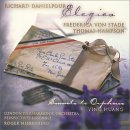
Danielpour: Elegies, Sonnets to Orpheus
Sony SK 60850

reviewed by Christopher Coleman
recorded at RTHK Radio 4 (Hong Kong) July 12, 2001
for CD Gallery hosted by Gladys Lau
Track 1: beginning to 4:10 (fade out quickly)
This lovely lyrical writing opens American composer Richard Danielpour's Elegies for mezzo-soprano, baritone and orchestra. Heavily influenced by the music of Gustav Mahler, Richard Strauss, and Benjamin Britten, Danielpour's music is representative of the reactionary trend away from the twin worlds of dissonant, hypercomplex music and aleatoric, chaotic music of the academic world from the 1950's through the 70's. Danielpour, a graduate of the Julliard School of Music, composes music which is primarily melodic and whose harmonies are derived from an in-depth knowledge of tonality, even if that tonality is often expanded beyond romantic norms. Here is a bit of the second movement, Lacrimosa, which calls to mind Benjamin Britten's War Requiem.
Track 2: beginning--fade out quickly after 2:00
The performances on this CD are uniformly gorgeous. The Perspectives Ensemble and the London Philharmonic Orchestra, both led by conductor Roger Nierenberg, provide superb support for the vocal soloists. Mezzo-soprano Frederica von Stade, baritone Thomas Hampson, and soprano Ying Huang complement Danielpour's lyricism wonderfully with their vocal gifts. In fact, von Stade contributes quite a bit more to this CD than just her singing talent; the genesis of Danielpour's Elegies began with the singer. Frederica von Stade's father was killed in World War II, before she was born, and she had longed to know him, but the only way for her to do so was through the reminiscences of others and the letters he had written to his wife. She suggested to conductor Roger Nierenberg that a song cycle based on those letters be composed; Nierenberg suggested Danielpour; and Danielpour enrolled poet Kim Vaeth to adapt those letters into a musically useful form. Although how those adaptations derive from the original letters is not at all clear from the information given, the entirety is very moving. Let's listen now to the climax of the work, an excerpt from the fourth movement, Litany.Track 4: beginning to 2:46 (fade out)
Very dramatic music, indeed. You may have noticed, however, that the actual climax was played by the orchestra, and the vocalists did not participate. This is the one criticism I have of the works--Danielpour's vocal writing is certainly exquisite, but he seems to undercut the drama of his music somewhat by omitting any real vocal climax. Other listeners may also find that a bit too much of the CD is introspective in nature, but given the subject matter of the works contained this seems inevitable. Regardless of these minor criticisms, this is a wonderful disc, and I will be listening to it repeatedly. The companion work to Elegies is Danielpour's setting of Rainier Maria Rilke's Sonnets to Orpheus, for soprano and chamber ensemble. This piece is quite similar to the first work, although perhaps a bit more lighthearted in places. Chinese soprano Ying Huang performs beautifully. Her enunciation of the English texts even surpasses that of American Frederica von Stade. Ying Huang may be known to audiences from her performance in the title role of Frédéric Mitterrand's 1995 film of Puccini's Madame Butterfly. Unfortunately the names of the other musicians are not provided--in particular the french horn player deserves mention. Let's close with an extract from the second movement of Danielpour's Sonnets to Orpheus, "Dance the Orange".Track 7: 2:30--5:15
Return to Music Criticism and Commentary